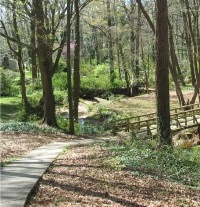
Client:
|
DECATUR PRESERVATION CORRIDOR MASTER PLAN |
| Decatur, Georgia | |
| The City of Decatur has experienced a renaissance in urban redevelopment and infill mixed-use developments in the past decade. The relationship of the downtown to the established and new neighborhoods and the growth in pedestrian and bicycle uses for work and leisure has become the impetus for evaluating a City-wide system that reinforces and builds upon the historic linkages and design principles.
The Decatur Preservation Corridor Master Plan initially focused on the development of a north/south trail planning effort with the intent of linking four community open spaces. As a “demonstration project”, it would be a prototype for future components of a total greenway/bicycle system. During the community participation process, it became apparent that a significant number of Decatur citizens, stakeholders, and Advisory Committee members supported the development of a visionary plan for a City-wide system. In response to this, the TSW planning team developed a comprehensive trail and alternative transportation plan that links all of Decatur’s neighborhoods and historical, cultural and environmental resources. The plan includes a network of multi-use trails, bike lanes, and sidewalks that connect the city’s parks, schools, shopping centers, and historic sites. It also includes provisions for the installation of wayfinding signs, bike racks, and other necessary infrastructure to support the expansion of alternative transportation options. The trail system is designed to be accessible and inclusive, catering to a wide range of users including walkers, joggers, cyclists, and persons with disabilities. The Decatur Preservation Corridor Master Plan is designed to create a more livable, sustainable, and healthy community by promoting active transportation and encouraging physical activity. In summary, TSW was retained by the City of Decatur to develop a comprehensive trail and alternative transportation plan that links all of Decatur’s neighborhoods and historical, cultural, and environmental resources. |
|


